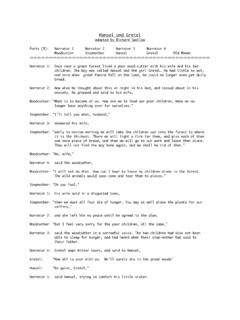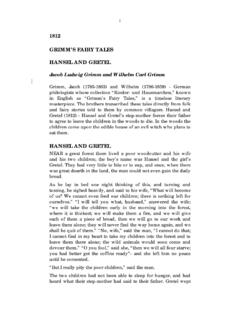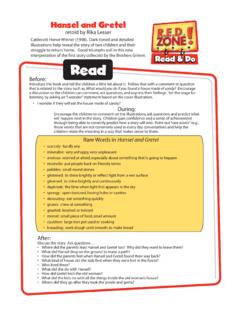Transcription of HANSEL AND GRETEL by James Marshall
1 HANSEL AND GRETEL by James Marshall The story of HANSEL and GRETEL is a sad one. Due to financial hardship, their parents leave them alone in the woods. Of course the up side is that while they are lost in the forest they come upon a little house. AND, the house is made all of candy! This is the witch's lure tempt children into her trap. (I always want to gloss over the part about her fattening the children up to eat!) When I was a child I thought a house made of candy would be a wonderful thing; I'm sure your children would agree. The activities for this tale all use candy -- not really a waste because each child may subsequently eat his creation. To transition to the activities, talk to the children about the candy house in HANSEL and GRETEL .
2 What kinds of candy can they see? Talk to them about their experiences with candy -- when do they eat it? Steer them in the desired direction by asking any of the following questions. When they get candy or raisins for Halloween in those little packages, are all of the packages the same? Ask them if they have ever made a small house, perhaps a gingerbread house for Christmas. If not, now's their chance. Have them imagine a pile of chocolate, jelly beans, licorice sticks, cookies, gumdrops, M&Ms, butterscotch, and every confection they love. MATERIALS: Activity #1: 12 graham crackers per child (they will only need 9-10, but the crackers break easily), 1 box per each 3-4 children of confectioner's sugar, water or milk (to mix with the sugar to make "glue"), assorted candies to use to decorate the "gingerbread" houses.
3 Activity #2: one box per four children of multicolored round toothpicks (the regular ones break too easily), 1 bag per four children of small gumdrops, tape measures, one paper cup per group, pennies or other uniform "weights", paper clips; Activity #3: one small box of raisins per child, one large piece poster board (I like yellow for contrast!), pencils, scratch paper, glue or masking tape. Activity #4: one "fun-size" packet of M&Ms per child, worksheet, crayons, one large piece poster board (I like blue for contrast!), glue or masking tape TEACHER NOTES: As you can see, materials for all of the activities can be costly, but we thought we'd give you several options. These are really good activities to do in conjunction with Christmas or Halloween; ask the children to bring in their extra Trick or Treat candy.
4 The day after Halloween is a great time to buy the candy for these activities because so much of it is available at half price; you can easily keep it to make the "gingerbread" houses at Christmas (believe me, the children won't care if the candy's a little stale!) ACTIVITY #1. "Gingerbread" houses: Have your children work in groups of two or three. Although they will each construct their own house, sometimes an extra pair of hands is needed while the "glue" sets up. Have each child draw a simple gingerbread house; model examples for them on the chalkboard. Have them draw possible candy decorations. Have each child estimate how many graham crackers it will take to construct his/her house.
5 (For older children, have them compute the surface area and/or the volume). Have children wash their hands thoroughly, before starting construction and as needed during all phases of construction, including decoration. Distribute 9-10 graham crackers per child; emphasize the crackers fragility. Distribute premixed glue . Experiment to get the right consistency (this varies with temperature and humidity if you are really brave, you could have the children mix it, and evaluate the best mix, but this can waste a lot of sugar and $$$). The mixture should be stiff, but spreadable. Have the groups work together to build their houses. Provide space for the houses to dry and set. This may take days (also a function of temperature and humidity).
6 When the houses have dried, have each child decorate his/her house, following their original drawing as closely as possible, with candy brought from home (if possible) and glue . Allow to set again before having them take theirs home. ACTIVITY #2. Gumdrop skyscrapers: (This activity was taken from the Winter 2000 issue of Scientific American Explorations, ) Models provide engineers with clues about how strong and stable a life-size structure will be. Use toothpicks and gumdrops to build a few models in various shapes to show the children; include squares, triangles, cubes, and pyramids. Pass around the models for the children to examine. Have them compare the sturdy triangular models to the more wobbly rectangular ones.
7 Hand out the toothpicks and the gumdrops. Give the children a few minutes to play around with them, and then challenge them to make the tallest buildings they can. When they are done they can use their measuring tapes to determine which framework is the tallest. Have the children evaluate the various structures and predict which will be the strongest and, if possible, why. Next, have them test the structures for strength. Be sure the children realize their models will be tested to the breaking point!, To test for strength, put a paper cup on the top-of each structure or attach it to the side with paper clips. Keeping a record of how many pennies they use, have the children add pennies to the cup, one at a time, until the model topples.
8 Record total amount of pennies for comparison. Have them evaluate their predictions in light of the results. TEACHER NOTES: Graphing is a fun activity anyway, and if one gets to graph sweets and then eat them, it's even better. And did you know that all individual packets/boxes of raisins and M&Ms are not created equal? After these activities with your students you will all know! ACTIVITY #3. Raisin Graph(s): Talk with students about "equalness" in packaging. They will investigate their own packets to see if they are, indeed, equal. Distribute raisin packets to students and tell them to take the raisins out of the box, count them, and record the number on their piece of paper.
9 They may then eat the raisins. When all have counted, ask the students to tell you (one at a time) how many raisins are in their boxes. After posting an amount once on the chalkboard, make tally marks for each additional amount that's the same. On the poster board, make a column for each of the different reported numbers. Have each student glue or tape his/her empty raisin box in the correct column for an informative pictograph. Discuss possible reasons for variations. Are the boxes packed by weight? Do all raisins weigh the same amount? ACTIVITY #4. M&M Graphs: Repeat Activity #3 with M&Ms. As the students count their M&Ms, have them separate them into colors and make an individual color bar graph of their packets of M&Ms using the accompanying sheet.
10 Compare results. Make group pictograph with the empty packets as with raisin packets. STANDARDS: BSL: , , , , , , , , , , NCTM: 4d, 9a, 9b, 9c, 10a, 10b SCS: B2, E2, H5 HANSEL and GRETEL . [Once-Upon-a-Time-Tale] Adapted by Jane Jerrard. Illus. by Susan Spellman: Publications International, Ltd., c1992. ISBN#1561734950. HANSEL and GRETEL . Retold and illus. by James Marshall . NY: Scholastic Inc., c1990. ISBN#0590449907. HANSEL and GRETEL . Retold by Rika Lesser. Illus. by Paul O. Zelinsky. NY: Putnam's Sons, c1984. 1 SBN#0399217258. Marshall , James . , HANSEL and GRETEL . NY: Scholastic Inc, c1999. ISBN#0590449907. How many M&MS are in Your Bag? Color 1 2 3 4 5 6 7 8 9









